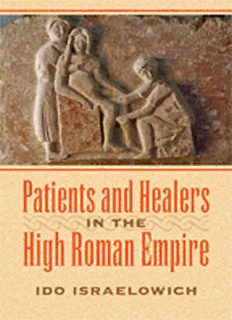
Patients and Healers in the High Roman Empire PDF
Preview Patients and Healers in the High Roman Empire
Patients and Healers in the High Roman Empire This page intentionally left blank Patients and Healers in the High Roman Empire Ido Israelowich Johns Hopkins University Press Baltimore © 2015 Johns Hopkins University Press All rights reserved. Published 2015 Printed in the United States of America on acid- free paper 9 8 7 6 5 4 3 2 1 Johns Hopkins University Press 2715 North Charles Street Baltimore, Maryland 21218- 4363 www.press.jhu.edu Library of Congress Cataloging- in-Publication Data Israelowich, Ido, 1972– , author. Patients and healers in the High Roman Empire / Ido Israelowich. p. ; cm. Includes bibliographical references and index. ISBN 978- 1- 4214- 1628- 1 (hardcover : alk. paper) — ISBN 1- 4214- 1628- x (hardcover : alk. paper) — ISBN 978- 1- 4214- 1629- 8 (electronic) — ISBN 1 -4 214-1 629-8 (electronic) I. Title. [DNLM: 1. Delivery of Health Care—history—Roman World. 2. Health Knowledge, Attitudes, Practice—Roman World. 3. Health Manpower—history—Roman World. 4. History, Ancient— Roman World. 5. Religion and Medicine—Roman World. WZ 51] R138 610.938—dc23 2014024709 A cata log record for this book is available from the British Library. Special discounts are available for bulk purchases of this book. For more information, please contact Special Sales at 4 10- 516- 6936 or specialsales@ press.jhu.edu. Johns Hopkins University Press uses environmentally friendly book materials, including recycled text paper that is composed of at least 30 percent p ost- consumer waste, whenever possible. In memory of my father, Victor Israelowich (1948–2012) This page intentionally left blank Contents Ac know ledg ments ix Introduction 1 1 The Identity of Physicians during the High Roman Empire 11 The Establishment of Medicine as a Profession in Rome 12 The Nature of the Medical Market Place during the High Roman Empire 30 The Case of Psasnis 35 Conclusion 43 2 Patients’ Understanding of Health and Illness 45 Patients and Their Healers 46 Physicians and Temple Medicine 52 Aelius Aristides 63 Conclusion 67 3 The Domus and Reproduction 70 Childbirth 71 Physicians and Midwives 76 Mothers’ Experiences 84 Conclusion 85 4 Health Care in the Roman Army 87 Theoretical Background 88 The Establishment of the Roman Imperial Medical Corps 92 The Responsibilities of the Army Physician and of the Medical Corps 96 Military Physicians and Local Populations 105 Conclusion 108 viii Contents 5 Medical Tourism during the High Roman Empire 110 Temples 111 Water 117 Cities 124 Conclusion 134 Conclusion 135 Notes 139 Bibliography 173 Index 185 Ack nowl edgm ents In the course of writing this book I have benefited from the kindness and gener- osity of institutions and individuals. I was fortunate enough to have been awarded a Yad Hanadiv Fellowship during the years 2008–10. During this time the De- partments of History and Classics at Tel Aviv University offered me a home and teaching opportunities. It was during this period that some of the main themes presented here w ere formulated and tested. Later I had the good fortune to be- come a permanent member of the Classics Department in Tel Aviv, where col- leagues and students provided a stimulating and pleasant working environment. In 2013 I was elected as a Sen ior Common Room Member by Wadham College, where I previously was a graduate student. I am grateful to the Warden and Fellows of Wadham for their kind support throughout my periods in Oxford. The staff members at Tel Aviv University library and in the Sackler and Bodleian Libraries in Oxford have been ever helpful and kind. I am grateful to them all. Various people assisted me in the pro cess of writing this book by reading sec- tions of the manuscript and discussing some of the key questions topics. I am particularly grateful to Professor Alan Bowman, Dr. Rebecca Flemming, Profes- sor Benjamin Isaac, Professor Irad Malkin, Professor Robert Parker, Professor Jonathan Price, and Professor Philip van der Eijk. A special thanks is due to Pro- fessor Benjamin Isaac for his long- standing assistance and encouragement. I am particularly grateful to Professor Manfred Horstmanshoff, who read the entire manuscript and discussed it with me on more than one occasion. I would also like to thank my two research assistants, Anna Charny and Naama Cohen, and the staff at Johns Hopkins University Press. Of course, I alone am responsible for the contents of this book, but it would have been less coherent and more prone to inaccuracies if it were not for this kind assistance. Finally, I wish to thank my friends and family, especially Talia.
Description: